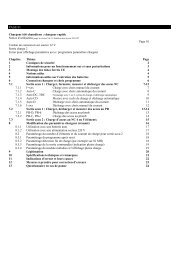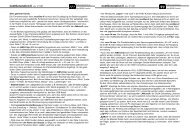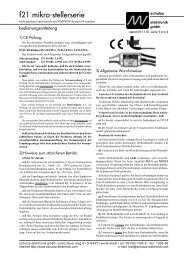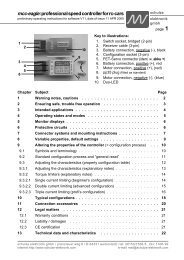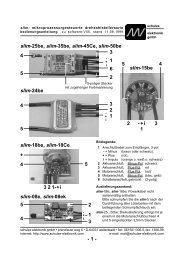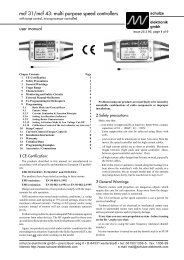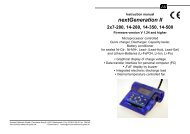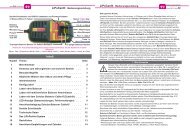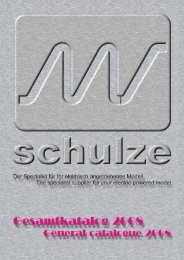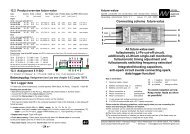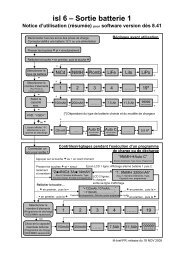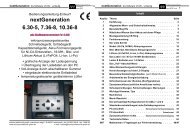LiPoCard up to V6 - Schulze Elektronik GmbH
LiPoCard up to V6 - Schulze Elektronik GmbH
LiPoCard up to V6 - Schulze Elektronik GmbH
You also want an ePaper? Increase the reach of your titles
YUMPU automatically turns print PDFs into web optimized ePapers that Google loves.
3e<br />
Page Issue 09.05 <strong>LiPoCard</strong> - Operating instructions for V 5 <strong>up</strong><br />
<strong>LiPoCard</strong> - Operating instructions for V 5 <strong>up</strong><br />
2 How <strong>to</strong> obtain reliable, trouble free operation<br />
It is essential <strong>to</strong> protect the charger from direct sunshine, dust, damp and rain. If the unit gets wet, dry it<br />
out thoroughly and have it checked and cleaned before re-use.<br />
The unit produces considerable heat in use. Allow excess heat <strong>to</strong> dissipate.<br />
Check the unit regularly for damage and/or poor contact between cab-les and connec<strong>to</strong>rs.<br />
Keep the charge cables as short as possible. Cables longer than 20 cm cannot be used if you wish <strong>to</strong><br />
conform <strong>to</strong> CE regulations. The internal battery wiring must also be as short as possible - especially <strong>to</strong><br />
protect the connected speed controllers against damage in use. Cable cross-section should be 2.5mm2 when you charge with more than 2 amps charge current.<br />
The charge cable should be fitted with high-quality gold-contact connec<strong>to</strong>rs at both ends.<br />
Twist charge leads <strong>to</strong>gether <strong>to</strong> minimise interference radiation.<br />
It is not permissible <strong>to</strong> operate the <strong>Schulze</strong> <strong>LiPoCard</strong> while the power source (car battery) is being<br />
charged by a conventional battery charger. It is generally possible <strong>to</strong> operate the unit from a stabilised<br />
mains PSU (11 - 13.8 V), provided that it has a current capacity of at least 7 A, but it is still essential that<br />
you check the compatibility of the system.<br />
Where individual cells are <strong>to</strong> be charged simultaneously, they must be soldered <strong>to</strong>gether <strong>to</strong> ensure that<br />
the <strong>Schulze</strong> <strong>LiPoCard</strong> operates correctly.<br />
The <strong>Schulze</strong> <strong>LiPoCard</strong> only sets the charge current calculated for a particular pack if that current does<br />
not cause any of the charger's parameters <strong>to</strong> be exceeded.<br />
The information and charging currents stated by the battery manufacturer must be observed at all times.<br />
3 Commonly used terms<br />
Final charge voltage: the voltage at which the battery’s charge limit (or capacity limit) is reached. When<br />
the <strong>Schulze</strong> <strong>LiPoCard</strong> is in use, the current is reduced <strong>to</strong> less than 8% of the configured value at this<br />
point. The charger then switches off, and displays the “battery full” indica<strong>to</strong>r.<br />
Final discharge voltage: the voltage at which the battery's discharge limit is reached. The chemical<br />
composition of the batteries determines the level of this voltage. Below this voltage the battery enters the<br />
deep discharge zone. Deep discharged cells can cause permanent damage<br />
Power-On (- reset): the status of the <strong>Schulze</strong> <strong>LiPoCard</strong> after it has been connected <strong>to</strong> the car<br />
battery.<br />
Ready display: the charger is ready (batteries disconnected) <strong>to</strong> operate at the currently selected<br />
configuration. When in this state the unit displays the set configuration by means of continuously glowing<br />
LEDs.<br />
Lademenge, Kapazität: siehe C und Ah bzw. mAh.<br />
C: Coulomb or capacity: Unit of measurement relating <strong>to</strong> the quantity of charged energy. In conjunction<br />
with charge current data this unit is used <strong>to</strong> determine the recommended / prescribed charge current<br />
of a battery of a given capacity. Example: if the charge current of a 1100 mAh battery is 2,2 A, we refer <strong>to</strong><br />
this as a charge of 2 C.<br />
A, mA: unit of measurement relating <strong>to</strong> charge or dis-charge current. 1000 mA = 1 A (A=Ampere,<br />
mA=Milliampere). Do not mix <strong>up</strong> with:<br />
Ah, mAh: unit of measurement for the capacity of a battery (Amperes x time unit; h = hour). If a pack is<br />
charged for one hour at a current of 2 A, it has been fed 2 Ah of energy. It receives the same quantity of<br />
charge (2 Ah) if it is charged for 4 hours at 0.5 A, or 15 minutes (=1/4 h) at 8 A.<br />
Operating Instructions<br />
Issue 09.05, Page 4e<br />
4 Useful information about Lithium batteries (Li-Io & Li-Po) and their maintenance<br />
Li-Io (Lithium-Ion) cells are housed in a strong metal can, usually of cylindrical shape. Their designation is derived<br />
from the <strong>to</strong>xic ion-conducting fluid electrolyte. The rigid metal container is required <strong>to</strong> ensure that the electrodes<br />
are pressed firmly enough against the separa<strong>to</strong>r. Li-Io cells of cylindrical and prismatic format have been in<br />
existence for many years; they were originally stated <strong>to</strong> have a nominal voltage of 3.6 V, with a maximum charge<br />
voltage of 4.1 V.<br />
Some distribution companies now state a maximum charge voltage of 4.2 V for the Li-Io cells which have been<br />
developed more recently. In our opinion we should always rely <strong>up</strong>on the voltages stated by the cell manufacturer,<br />
i.e. the company which designed the cell.<br />
As a basic rule the Li-Io cells stated <strong>to</strong> be safe at 4.2 V can also be charged <strong>to</strong> 4.1 V. If you do this, you can<br />
usually - depending on the cell design - expect a slight extension of useful battery life, combined with a reduction<br />
in usable capacity.<br />
Li-Po (Lithium-Polymer) cells derive their designation from the polymer foil which was originally used as the<br />
electrolyte. This “solid” electrolyte was only capable of s<strong>up</strong>plying current at temperatures of around 60ºC or<br />
higher; later the electrolyte was enriched with various s<strong>up</strong>plementary materials <strong>to</strong> provide improved conductivity.<br />
The characteristics of these new cells made it possible <strong>to</strong> house them in a lightweight foil pack (“flat-pack”); these<br />
cells now provide a very high performance even at room temperature, although they still have slightly more <strong>to</strong> offer<br />
at 60ºC.<br />
The uniform nominal voltage of these cells is stated as 3.7 V, the maximum charge voltage as 4.2 V.<br />
As the differences between the types is generally not made clear in the modelling world, we provide the following<br />
definitions:<br />
Nominal voltage LiIo: 3.6 V / cell (SAFT)<br />
Nominal voltage LiIo/LiPo: 3.7 V / cell (SANYO, KOKAM)<br />
Max. charge voltage LiIo: 4.1 V +-40mV / cell (SAFT)<br />
LiPo: 4.2 V +-50mV / cell (MoliCel)<br />
absolute limit 4.3 V / cell<br />
Min. discharge voltage LiIo: 2.5 V / cell (MoliCel), 2.7V/Z.(SANYO)<br />
LiPo: 3.0 V / cell (KOKAM)<br />
absolute limitt 2.3 V / cell<br />
Number of cells <strong>to</strong> be selected on the <strong>Schulze</strong> <strong>LiPoCard</strong>:<br />
Nominal voltage of LiPo-pack div.by nominal cell-voltage = cell count.<br />
--> 11,1 V LiPo-pack divided by 3.7 V => select 3 cells!<br />
If you would select more, the pack would explode during charging - if the cell count moni<strong>to</strong>ring circuit of<br />
the <strong>Schulze</strong> <strong>LiPoCard</strong> would fail.<br />
Example: The ThunderPower TP8200 3s4p pack consists of 12 cells.<br />
4 of 2050mAh are connected parallel (4p) -> 4 * 2,05 Ah = 8200mAh.<br />
3 of the paralleled cells are connected in series (3s)-> 3*3,7V= 11,1 V.<br />
Selecting the fitting cell type:<br />
Select that battery type (Li-Ion bzw. Li-Poly), which characteristics match best with the data sheet of<br />
the battery manufacturer.<br />
Selecting the fast charge current - if the manufacturer does not specify other values:<br />
Charge current = 1 C (SANYO / KOKAM) or less (0,7 C PANASONIC) (C = nominal battery capacity).<br />
Maximum continous discharge current when used as a drive battery:<br />
Depending on the cell type: 1 ... 20 C continous current..<br />
Long time s<strong>to</strong>rage:<br />
Empty, i.e. discharged <strong>to</strong> the discharge voltage cut off level (see maintenance), at low temperature (-<br />
20°C bis +10°C).<br />
Maintenance: Discharge <strong>up</strong> <strong>to</strong> 1 C down <strong>to</strong> the above listed discharge voltages. Always s<strong>to</strong>re these<br />
cells in the discharged state. If s<strong>to</strong>red fully charged over a longer period, the result can be a permanent<br />
reduction in capacity.<br />
When s<strong>to</strong>red at +40°C or more charge them additionally a little bit every two months.



